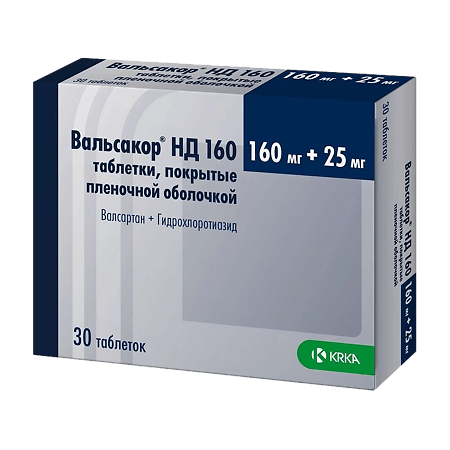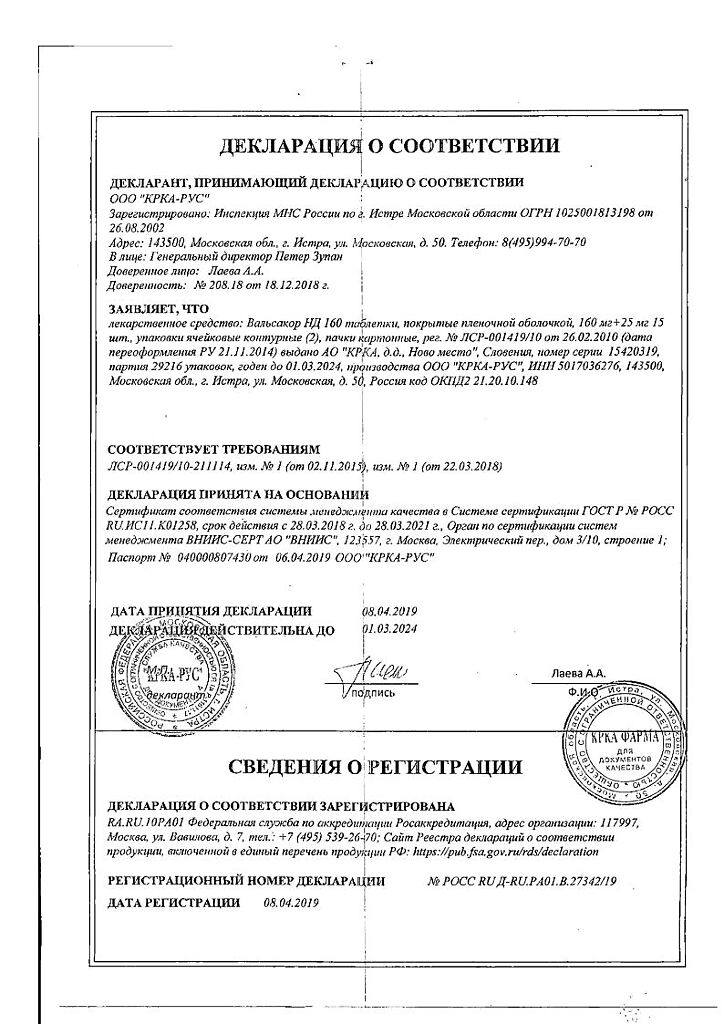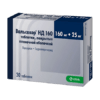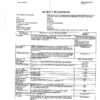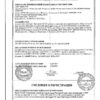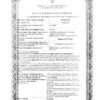Subtotal: €40.18
Valsacor ND160,160 mg+25 mg 30 pcs
€18.18 €15.15
hypotensive agent combined (angiotensin II receptor antagonist + diuretic)
Indications
Arterial hypertension (patients for whom combination therapy is indicated).
Pharmacological effect
combined antihypertensive drug (angiotensin II receptor antagonist + diuretic)
Special instructions
Concomitant use of potassium-sparing diuretics, potassium supplements, potassium-containing nutritional supplements or other drugs that can increase potassium levels in the blood serum (for example, heparin), conditions accompanied by water and electrolyte disturbances: nephropathy with salt loss and prerenal (cardiogenic) renal dysfunction, hypokalemia, hypomagnesemia, hypercalcemia, chronic heart failure (CHF) III-IV functional class according to the NYHA classification, severe hyponatremia and/or conditions accompanied by a decrease in BCC (including diarrhea, vomiting, high-dose diuretic therapy), bilateral or unilateral stenosis of the renal arteries or stenosis of the artery of a single kidney, condition after kidney transplantation, primary hyperaldosteronism, stenosis of the aortic and/or mitral valve, hypertrophic obstructive cardiomyopathy (HOCM), systemic lupus erythematosus (SLE), history of non-melanoma skin cancer (NMSC) (see section “Special Instructions”), diabetes, hypercholesterolemia, hypertriglyceridemia, angle-closure glaucoma, in patients with hereditary angioedema, or angioedema due to previous therapy with ARB II or ACE inhibitors.
Contraindicated for persons under 18 years of age (efficacy and safety of use in children have not been proven).
Renal dysfunction
Patients with mild to moderate renal impairment (creatinine clearance more than 30 ml/min (0.5 ml/sec)) do not require dose adjustment of Valsacor® ND 160.
Liver dysfunction
The maximum recommended daily dose of valsartan in patients with mild (5-6 points on the Child-Pugh scale) or moderate (7-9 points on the Child-Pugh scale) liver dysfunction without cholestasis is 80 mg.
Double blockade of the RAAS
The simultaneous use of ARB II, including valsartan, with drugs containing aliskiren is contraindicated in patients with diabetes and/or with moderate or severe renal impairment (GFR less than 60 ml/min/1.73 m2 body surface area) and is not recommended in other patients.
Concomitant use of ARB II with ACE inhibitors is contraindicated in patients with diabetic nephropathy and is not recommended in other patients.
Renal dysfunction
In patients with impaired renal function (creatinine clearance more than 30 ml/min), no change in the dose of the drug is required. When using the drug Valsacor® ND 160 in patients with impaired renal function, it is recommended to regularly monitor the potassium content, creatinine and uric acid concentrations in the blood plasma.
Condition after kidney transplantation
The safety of Valsacor® ND 160 in patients who have recently undergone kidney transplantation has not been established.
Stenosis of the aortic and/or mitral valves, HOCM
The drug Valsacor® ND 160 should be used with caution in patients with hemodynamically significant stenosis of the aortic and/or mitral valves or with HOCM.
Liver dysfunction
The drug Valsacor® ND 160 is not recommended for patients with impaired liver function. The maximum recommended daily dose of valsartan in patients with mild or moderate liver dysfunction without cholestasis is 80 mg.
Water-electrolyte imbalance
When using thiazide diuretics, including HCTZ, there have been cases of hypokalemia, hyponatremia and hypochloremic alkalosis, hypomagnesemia (as the excretion of magnesium by the kidneys increases) and hypercalcemia (as the excretion of calcium by the kidneys decreases). When using the drug Valsacor® ND 160, it is recommended to regularly monitor the content of electrolytes (especially potassium) in the blood serum.
Hyponatremia and/or decreased blood volume
In patients with severe hyponatremia and/or with reduced blood volume (for example, when taking high doses of diuretics), in rare cases, at the beginning of therapy with Valsacor® ND 160, a pronounced decrease in blood pressure with clinical manifestations is possible. Therefore, at the beginning of treatment, the sodium content in the blood serum should be corrected and/or the bcc should be replenished.
If a pronounced decrease in blood pressure develops, the patient should be transferred to a horizontal position with legs elevated, and, if necessary, given an intravenous infusion of 0.9% sodium chloride solution. After stabilization of blood pressure levels, treatment with Valsacor® ND 160 can be continued.
CHF III-IV functional class (NYHA classification) or other diseases accompanied by stimulation of the RAAS
In patients whose renal function depends on the state of the RAAS (for example, CHF III-IV functional class according to the NYHA classification), therapy with ACE inhibitors may be accompanied by oliguria and/or progressive azotemia, and in rare cases, acute renal failure. It is impossible to exclude the development of renal dysfunction due to suppression of RAAS activity while taking Valsacor® ND 160. Therapy with Valsacor® ND 160 should be carried out with caution, under the monitoring of renal function.
Primary hyperaldosteronism
The drug Valsacor® ND 160 is not effective for the treatment of hypertension in patients with primary hyperaldosteronism due to the lack of activation of the RAAS.
Renal artery stenosis
In patients with unilateral or bilateral renal artery stenosis or stenosis of the artery of a single kidney, the drug should be used with caution, as it is possible to increase the concentrations of creatinine and urea in the blood plasma.
Systemic lupus erythematosus
When using thiazide diuretics (including HCTZ), cases of exacerbations and worsening of connective tissue diseases (for example, SLE) have been described.
Photosensitivity
Cases of the development of photosensitivity while taking HCTZ have been described. If manifestations of photosensitivity develop, it is recommended to discontinue therapy. If it is necessary to continue therapy, it is recommended to protect exposed areas of the body from exposure to sunlight and ultraviolet (UV) rays.
NMRK
Two pharmacoepidemiological studies using data from the Danish National Cancer Registry demonstrated an association between HCTZ use and an increased risk of NMSC basal cell carcinoma and squamous cell carcinoma. The risk of developing NMSC increased with increasing total (cumulative) dose of HCTZ. A possible mechanism for the development of NMSC is the photosensitizing effect of HCTZ.
Patients taking HCTZ as monotherapy or in combination with other drugs should be aware of the risk of developing NMSC. It is recommended that such patients undergo regular skin examination to identify any new suspicious lesions as well as changes in existing skin lesions.
Any suspicious skin changes should be reported to your doctor immediately. Suspicious areas of skin should be examined by a specialist. To clarify the diagnosis, histological examination of skin biopsies may be required.
To minimize the risk of developing NMSC, patients should be advised to follow preventive measures, such as limiting exposure to sunlight and UV rays, and using appropriate protective equipment.
In patients with a history of NMSC, it is recommended to reconsider the advisability of using HCTZ.
Other metabolic disorders
Thiazide diuretics, including HCTZ, may cause changes in glucose tolerance and increases in plasma concentrations of cholesterol, triglycerides and uric acid.
Patients with diabetes may require dose adjustment of insulin or oral hypoglycemic agents.
Thiazide diuretics reduce renal calcium excretion and may cause a slight increase in plasma calcium in the absence of concomitant disorders of calcium metabolism. Severe hypercalcemia during the use of a thiazide diuretic may indicate hyperparathyroidism. Before testing parathyroid function, thiazide diuretics, including HCTZ, should be discontinued.
Anti-doping test
HCTZ may give a positive result during doping control.
Hypersensitivity reactions
Hypersensitivity reactions during the use of HCTZ were most often observed in patients with a history of allergic reactions and bronchial asthma.
When using valsartan, patients have experienced the development of angioedema, including swelling of the larynx and vocal cords leading to airway obstruction, and/or swelling of the face, lips, pharynx and/or tongue. Some of these patients had a history of angioedema due to the use of other drugs, including ACE inhibitors. If angioedema develops, you should immediately discontinue the drug Valsacor® ND 160 and do not resume treatment with the drug.
Acute attack of angle-closure glaucoma
Cases of transient myopia and acute development of angle-closure glaucoma have been reported during the use of HCTZ. A risk factor for the development of acute angle-closure glaucoma may be a patient’s history of allergic reactions to sulfonamides and penicillin.
Symptoms include sudden onset, sudden decrease in visual acuity, or eye pain, usually occurring within a few hours to a week after starting therapy. Untreated angle-closure glaucoma can lead to permanent vision loss.
First of all, it is necessary to stop taking HCTZ as quickly as possible. If intraocular pressure remains uncontrolled, emergency medical or surgical treatment may be required.
Special information on excipients
The drug Valsacor® ND 160 contains lactose, so it should not be used in the following conditions: lactose intolerance, lactase deficiency or glucose-galactose malabsorption syndrome.
Due to the possibility of dizziness or weakness while using the drug Valsacor® ND 160, care must be taken when driving vehicles and working with other technical devices that require increased concentration and speed of psychomotor reactions.
Active ingredient
Valsartan, Hydrochlorothiazide
Composition
1 film-coated tablet contains:
Core:
Active ingredients:
Valsartan 160.00 mg
Hydrochlorothiazide 25.00 mg
Excipients:
Microcrystalline cellulose, croscarmellose sodium, povidone-K25, lactose monohydrate, magnesium stearate, colloidal silicon dioxide
Film shell: hypromellose 2910, titanium dioxide (E171), macrogol-4000, red iron oxide dye (E172), yellow iron oxide dye (E172)
Pregnancy
Pregnancy
Valsartan
The use of ARA II in the first trimester of pregnancy is not recommended. The use of ARA II is contraindicated in the II-III trimesters of pregnancy, since use in the II-III trimesters of pregnancy can cause fetotoxic effects (decreased renal function, oligohydramnios, delayed ossification of fetal skull bones) and neonatal toxic effects (renal failure, arterial hypotension, hyperkalemia). There are reports of spontaneous abortions in women, oligohydramnios, and renal dysfunction in newborns whose mothers unintentionally received valsartan during pregnancy.
If, nevertheless, the drug was used in the II-III trimesters of pregnancy, then it is necessary to conduct an ultrasound examination of the kidneys and bones of the fetal skull.
When planning pregnancy, it is recommended that the patient be transferred to alternative antihypertensive therapy, taking into account the safety profile.
Newborns whose mothers received ARA II during pregnancy require medical supervision, as there is a risk of developing arterial hypotension.
HCTZ
Experience with the use of HCTZ during pregnancy, especially in the first trimester, is limited. HCTZ crosses the placenta. When using thiazide diuretics in the II-III trimester of pregnancy, the development of thrombocytopenia, water-electrolyte imbalance, and jaundice in the fetus or newborn is possible.
If pregnancy is confirmed, Valsacor® ND 160 should be discontinued as soon as possible.
Breastfeeding period
There is no data on the excretion of valsartan into breast milk. HCTZ is excreted in breast milk in women. If it is necessary to use the drug Valsacor® ND 160 during lactation, you must stop breastfeeding.
Contraindications
Hypersensitivity to valsartan, hydrochlorothiazide and other sulfonamide derivatives or any other components of the drug.
Severe liver dysfunction (more than 9 points on the Child-Pugh scale), biliary cirrhosis and cholestasis.
Anuria, severe renal dysfunction (creatinine clearance less than 30 ml/min).
Refractory hypokalemia, hyponatremia, hypercalcemia and symptomatic hyperuricemia.
Concomitant use with aliskiren and drugs containing aliskiren in patients with diabetes mellitus and/or with moderate or severe renal impairment (glomerular filtration rate (GFR) less than 60 ml/min/1.73 m2 body surface area).
Concomitant use with ACE inhibitors in patients with diabetic nephropathy.
Pregnancy and pregnancy planning, breastfeeding period.
Age up to 18 years (efficacy and safety of use in children have not been proven).
Lactase deficiency, lactose intolerance, glucose-galactose malabsorption syndrome, since Valsacor® ND 160 contains lactose.
Side Effects
Classification of the incidence of side effects recommended by the World Health Organization (WHO):
very common ≥ 1/10
often ≥ 1/100 to < 1/10
uncommon ≥ 1/1000 to < 1/100
rarely from ≥ 1/10000 to < 1/1000
very rare <1/10000
frequency unknown cannot be estimated from available data.
When using a combination of valsartan/hydrochlorothiazide
Metabolic and nutritional disorders:
uncommon: dehydration.
Nervous system disorders:
often: headache;
uncommon: paresthesia;
very rarely: dizziness;
frequency unknown: fainting.
Visual disorders:
uncommon: decreased visual acuity.
Hearing and labyrinth disorders:
uncommon: tinnitus.
Vascular disorders:
uncommon: marked decrease in blood pressure, peripheral edema.
Disorders of the respiratory system, chest and mediastinal organs:
uncommon: cough;
frequency unknown: non-cardiogenic pulmonary edema.
Gastrointestinal disorders:
uncommon: nausea;
very rarely: diarrhea.
Musculoskeletal and connective tissue disorders:
uncommon: myalgia;
very rarely: arthralgia.
Renal and urinary tract disorders:
frequency unknown: renal dysfunction.
General disorders and disorders at the injection site:
uncommon: increased fatigue.
Laboratory and instrumental data:
frequency unknown: increased concentration of uric acid in the blood serum, increased concentration of bilirubin in the blood serum, increased concentration of creatinine in the blood serum, hyponatremia, hypokalemia, neutropenia, increased concentration of residual urea nitrogen in the blood serum.
When studying the clinical use of the fixed combination of valsartan/HCTZ in patients with hypertension, the following adverse events (AEs) were observed without an obvious connection with the drug: abdominal pain, pain in the upper abdomen, anxiety, arthritis, asthenia, back pain, bronchitis (including acute), chest pain, postural dizziness, dyspepsia, shortness of breath, dry oral mucosa, nosebleeds, erectile dysfunction. dysfunction, gastroenteritis, headache, increased sweating, hypoesthesia, flu-like condition, insomnia, sprains, muscle spasms, muscle hypertonicity, nasal congestion, nasopharyngitis, nausea, neck pain, peripheral edema, otitis media, pain in the extremities, rapid heartbeat, pain in the larynx and pharynx, pyrexia, pollakiuria, hyperthermia, sinusitis, drowsiness, upper respiratory tract infections, urinary tract infections, vertigo, viral infections, visual impairment.
Below are the AEs associated with the use of each component separately.
When using valsartan
Blood and lymphatic system disorders:
frequency unknown: decreased hemoglobin, decreased hematocrit, thrombocytopenia.
Immune system disorders:
frequency unknown: hypersensitivity/allergic reactions, including serum sickness.
Metabolic and nutritional disorders:
frequency unknown: increased potassium levels in the blood, hyponatremia.
Hearing and labyrinth disorders:
uncommon: vertigo.
Vascular disorders:
frequency unknown: vasculitis.
Gastrointestinal disorders:
uncommon: abdominal pain.
Disorders of the liver and biliary tract:
frequency unknown: increased activity of liver enzymes in the blood.
Disorders of the skin and subcutaneous tissues:
frequency unknown: angioedema, skin rash, pruritus, bullous dermatitis.
Renal and urinary tract disorders:
frequency unknown: renal failure.
The following AEs were observed when studying the clinical use of valsartan in patients with hypertension, regardless of their causal relationship with the use of valsartan: arthralgia, asthenia, back pain, diarrhea, dizziness, headache, insomnia, decreased libido, nausea, edema, pharyngitis, rhinitis, sinusitis, upper respiratory tract infections, viral infections.
When using thiazide diuretics, including HCTZ
Blood and lymphatic system disorders:
rarely: thrombocytopenia, sometimes with purpura;
very rarely: agranulocytosis, suppression of bone marrow hematopoiesis, hemolytic anemia, leukopenia;
frequency unknown: aplastic anemia.
Immune system disorders:
very rare: hypersensitivity reactions.
Metabolic and nutritional disorders:
very often: hypokalemia, increased concentrations of lipids in the blood plasma (especially against the background of high doses of HCTZ);
often: hyponatremia, hypomagnesemia, hyperuricemia;
rarely: hypercalcemia, hyperglycemia, glucosuria and worsening of diabetes;
very rare: hypochloremic alkalosis.
Mental disorders:
rarely: sleep disturbance, depression.
Nervous system disorders:
rarely: headache, dizziness, paresthesia.
Visual disorders:
rarely: visual impairment (especially in the first few weeks of treatment);
frequency unknown: acute attack of angle-closure glaucoma.
Cardiac disorders:
rarely: arrhythmias.
Vascular disorders:
often: orthostatic hypotension (may increase with simultaneous use with ethanol, sedatives or analgesics).
Disorders of the respiratory system, chest and mediastinal organs:
very rare: respiratory distress syndrome, including pulmonary edema and pneumonitis.
Digestive system disorders:
often: decreased appetite, moderate nausea and vomiting;
rarely: abdominal discomfort, constipation, diarrhea;
very rare: pancreatitis.
Disorders of the liver and biliary tract:
rarely: intrahepatic cholestasis or jaundice.
Renal and urinary tract disorders:
frequency unknown: renal dysfunction, acute renal failure (ARF).
Disorders of the skin and subcutaneous tissues:
often: urticaria and other forms of skin rash;
rarely: photosensitivity;
very rarely: necrotizing vasculitis and toxic epidermal necrolysis, lupus-like reactions, exacerbation of skin manifestations of SLE;
frequency unknown: erythema multiforme.
Musculoskeletal and connective tissue disorders:
frequency unknown: muscle spasms.
Disorders of the genital organs and breast:
often: impotence.
General disorders and disorders at the injection site:
frequency unknown: hyperthermia, asthenia.
Interaction
Common drug interactions for valsartan and hydrochlorothiazide
Concomitant use is not recommended
Lithium preparations
With the simultaneous use of ACE inhibitors, AR II or thiazide diuretics with lithium preparations, a reversible increase in the concentration of lithium in the blood plasma and the development of intoxication were observed. The risk of toxic effects associated with the use of lithium preparations may further increase when used simultaneously with Valsacor® ND 160, since the renal clearance of lithium preparations is reduced by the influence of thiazide diuretics. If simultaneous use with lithium preparations is necessary, the concentration of lithium in the blood plasma should be carefully monitored.
Concomitant use with caution
Other antihypertensive drugs
The antihypertensive effect may be enhanced when used simultaneously with other drugs that lower blood pressure (for example, ACE inhibitors, beta-blockers, slow calcium channel blockers (SCBCs), guanethidine, methyldopa, vasodilators, direct renin inhibitors, ARA II).
Pressor amines (eg, norepinephrine and epinephrine)
The effect of pressor amines may be weakened, which does not require discontinuation of the simultaneous use of valsartan and HCTZ.
Nonsteroidal anti-inflammatory drugs (NSAIDs), including selective cyclooxygenase-2 (COX-2) inhibitors
With simultaneous use of ARA II and HCTZ with NSAIDs, the diuretic and antihypertensive effects may be weakened. In conditions of hypovolemia, the development of acute acute renal failure is possible; it is recommended to monitor renal function at the beginning of therapy, as well as to carry out adequate replenishment of the patient’s blood volume.
Drug interactions for valsartan
Concomitant use is contraindicated
The simultaneous use of ARB II, including valsartan, with drugs containing aliskiren is contraindicated in patients with diabetes and/or with moderate or severe renal impairment (GFR less than 60 ml/min/1.73 m2 body surface area) and is not recommended in other patients.
Concomitant use of ARB II with ACE inhibitors is contraindicated in patients with diabetic nephropathy and is not recommended in other patients.
Concomitant use is not recommended
Potassium-sparing diuretics (spironolactone, eplerenone, triamterene, amiloride), potassium supplements, potassium-containing table salt substitutes and other drugs and substances that can cause an increase in serum potassium (for example, heparin)
If simultaneous use with drugs that affect potassium levels is necessary, it is recommended to monitor the potassium content in the blood plasma.
Concomitant use with caution
When used simultaneously with ARA II, including valsartan, with drugs that affect the RAAS, such as ACE inhibitors or aliskiren, the incidence of arterial hypotension, hyperkalemia, and renal dysfunction increases. It is necessary to monitor blood pressure, renal function, and electrolyte levels in the blood plasma in such patients.
Transport proteins
In vitro studies in liver cultures have shown that valsartan is a substrate for the transporter proteins OATP1B1/OATP1B3 and MRP2. Concomitant use of valsartan with inhibitors of the OATP1B1/OATP1B3 transport protein (rifampicin, cyclosporine) or MRP2 (ritonavir) may increase the systemic exposure of valsartan (Cmax and AUC). Caution must be exercised when starting simultaneous use with the above drugs or after their discontinuation.
No drug interactions
No clinically significant interactions have been identified with the following drugs: cimetidine, warfarin, furosemide, digoxin, atenolol, indomethacin, HCTZ, amlodipine and glibenclamide.
Drug interactions for HCTZ
Concomitant use with caution
Medicines that affect potassium levels in blood plasma
When used simultaneously with loop diuretics, glucocorticosteroids (GCS), adrenocorticotropic hormone (ACTH), amphotericin B, benzathine benzylpenicillin, carbenoxolone, laxatives, acetylsalicylic acid or its derivatives, the risk of a decrease in plasma potassium and hypokalemia increases. In this case, it is recommended to monitor the potassium content in the blood plasma.
Drugs that can cause polymorphic ventricular tachycardia of the torsade de pointes type
When using antiarrhythmic drugs of classes IA and III and some antipsychotic drugs (neuroleptics) with HCTZ, caution should be exercised, as there is a risk of developing pirouette-type arrhythmia against the background of possible hypokalemia. Monitoring of potassium levels in blood plasma is recommended.
Non-depolarizing peripheral muscle relaxants (tubocurarine)
HCTZ potentiates the action of muscle relaxants.
Hypoglycemic agents (oral and insulin)
With simultaneous use, dose adjustment of hypoglycemic agents may be required. Metformin should be taken with caution, since the development of lactic acidosis induced by renal failure while taking HCTZ is possible.
Medicines that affect plasma sodium levels
With long-term simultaneous use with antidepressants, anticonvulsants, antipsychotic (neuroleptic) drugs (for example, carbamazepine), etc., caution should be exercised, as the risk of developing hyponatremia increases. It is recommended to regularly monitor the sodium content in the blood plasma.
Cardiac glycosides
Hypokalemia and hypomagnesemia while taking thiazide diuretics may contribute to the development of cardiac arrhythmias in patients receiving cardiac glycosides.
N- and m-anticholinergics
H- and m-anticholinergic agents (atropine, biperiden) can increase the bioavailability of thiazide diuretics by reducing the peristaltic activity of the gastrointestinal tract (GIT) and slowing gastric emptying. Accordingly, gastrointestinal motility stimulants (cisapride) may reduce the bioavailability of thiazide diuretics.
Anion exchange resins (colestyramine and colestipol)
The absorption of thiazide diuretics, including HCTZ, is reduced with simultaneous use of cholestyramine or colestipol. Therefore, HCTZ should be taken 4 hours before or 4-6 hours after taking anion exchange resins.
Methyldopa
Isolated cases of the development of hemolytic anemia have been described with the simultaneous use of methyldopa and HCTZ.
Vitamin D and calcium salts
The simultaneous use of thiazide diuretics, including HCTZ, with vitamin D or calcium salts can lead to an increase in calcium levels in the blood plasma as a result of increased calcium reabsorption.
Cyclosporine
With simultaneous use of HCTZ and cyclosporine, the risk of developing hyperuricemia and symptoms similar to exacerbation of gout increases.
Radiocontrast agents containing iodine
Hypovolemia that develops while taking diuretics increases the risk of developing acute renal failure. It is necessary to replenish the blood volume before using products with a high iodine content (for example, radiocontrast agents containing iodine).
Medicines to treat gout (probenecid, sulfinpyrazone and allopurinol)
When using HCTZ, it is possible to increase the concentration of uric acid in the blood plasma, which may require dose adjustment of drugs for the treatment of gout (for example, increasing the dose of sulfinpyrazone and probenecid). Concomitant use with thiazide diuretics, including HCTZ, may lead to an increased incidence of hypersensitivity reactions to allopurinol.
Amantadine
Concomitant use with thiazide diuretics, including HCTZ, increases the risk of side effects from amantadine.
Beta blockers and diazoxide
Concomitant use with thiazide diuretics, including HCTZ, increases the risk of developing hyperglycemia.
Cytotoxic drugs (cyclophosphamide, methotrexate)
Concomitant use with thiazide diuretics, including HCTZ, reduces the excretion of cytotoxic drugs by the kidneys, which leads to potentiation of their myelosuppressive effect.
Ethanol, barbiturates and narcotic drugs
Concomitant use with thiazide diuretics, including HCTZ, may potentiate the development of orthostatic hypotension.
Overdose
Symptoms: the main expected manifestation of a valsartan overdose is a pronounced decrease in blood pressure, which can lead to impaired consciousness, collapse and/or shock. In case of an overdose of HCTZ, the following symptoms may develop: nausea, drowsiness, decreased blood volume, heart rhythm disturbances and muscle spasms caused by water-electrolyte imbalance.
Treatment: symptomatic and depends on the time elapsed since taking the drug and the severity of the symptoms. In case of early diagnosis of overdose, it is recommended to induce vomiting and/or lavage the stomach. Hemodynamic parameters should be stabilized. If there is a pronounced decrease in blood pressure, it is necessary to transfer the patient to a horizontal position with his legs raised up and replenish the blood volume (inject 0.9% sodium chloride solution intravenously) under the control of hemodynamics and diuresis. Valsartan is not eliminated by hemodialysis, as it is significantly bound to plasma proteins. HCTZ is eliminated by hemodialysis.
Clinical pharmacology
The drug Valsacor® ND 160 is a combined antihypertensive drug, which includes an angiotensin II receptor antagonist (ARA II) and a thiazide diuretic.
Pharmacodynamics
Valsartan
Valsartan is a selective ARA II for oral administration of a non-protein nature.
Selectively blocks AT1 receptors responsible for the vasopressor effect of angiotensin II. The consequence of AT1 receptor blockade is an increase in the concentration of angiotensin II in the blood plasma, which can stimulate unblocked AT2 receptors, which balances the vasopressor effects associated with the stimulation of AT1 receptors. Valsartan does not have agonist activity against AT1 receptors. Its affinity for AT1 receptors is approximately 20,000 times higher than for AT2 receptors.
Valsartan does not inhibit angiotensin-converting enzyme (ACE), also known as kininase II, which converts angiotensin I to angiotensin II and destroys bradykinin. Due to the lack of influence on ACE, the effects of bradykinin and substance P are not potentiated. The incidence of dry cough is lower in patients receiving ARA II compared to patients receiving ACE inhibitors. Valsartan does not interact with or block receptors of other hormones or ion channels involved in the regulation of the functions of the cardiovascular system.
In the treatment of arterial hypertension (AH), valsartan reduces blood pressure (BP) without affecting heart rate (HR).
After oral administration of a single dose of valsartan, the antihypertensive effect develops within 2 hours, and the maximum reduction in blood pressure is achieved after 4-6 hours. The antihypertensive effect of valsartan persists for 24 hours after its use. With continuous use of valsartan, the maximum reduction in blood pressure, regardless of the dose, is achieved after 2-4 weeks and is maintained at this level during long-term therapy. Simultaneous use with hydrochlorothiazide (HCTZ) allows achieving a significant additional reduction in blood pressure.
Sudden withdrawal of valsartan is not accompanied by a sharp increase in blood pressure or other undesirable clinical consequences.
HCTZ
The point of action of thiazide diuretics is the distal convoluted renal tubules. When thiazide diuretics act on highly sensitive receptors of the distal tubules of the renal cortex, the reabsorption of sodium (Na+) and chlorine (Cl-) ions is suppressed. Suppression of the Na+ and Cl- co-transport system apparently occurs due to competition for Cl- binding sites in this system, which leads to an increase in the excretion of Na+ and Cl- to approximately the same extent.
As a result of the diuretic effect, a decrease in circulating blood volume (CBV) is observed, as a result of which renin activity, aldosterone secretion, potassium excretion by the kidneys and, consequently, a decrease in the potassium content in the blood serum increase. The connection between renin and aldosterone is mediated by angiotensin II, therefore the decrease in serum potassium with simultaneous use of HCTZ with valsartan is less pronounced than with HCTZ monotherapy.
Pharmacokinetics
Valsartan
Suction
After taking valsartan orally, the maximum concentration (Cmax) in the blood plasma is achieved within 2-4 hours. The average absolute bioavailability is 23%. When taking valsartan with food, the area under the concentration-time curve (AUC) and Cmax in plasma are reduced by 40% and 50%, respectively. However, 8 hours after dosing of valsartan, taken on an empty stomach and with food, its plasma concentrations are the same. A decrease in AUC is not accompanied by a clinically significant decrease in the therapeutic effect of valsartan, so the drug can be taken regardless of meal time.
Distribution
The volume of distribution (Vd) of valsartan during the steady-state period after intravenous administration was approximately 17 L, indicating the absence of a pronounced distribution of valsartan in tissues. Valsartan actively binds to plasma proteins (94-97%), mainly to albumin.
Metabolism
Valsartan does not undergo significant biotransformation; only about 20% of the dose taken orally is excreted in the form of metabolites. The hydroxyl metabolite is detected in blood plasma in low concentrations (less than 10% of the AUC of valsartan). This metabolite has no pharmacological activity.
Removal
Valsartan is excreted in two phases: a-phase with a half-life (T1/2a) of less than 1 hour and b-phase with T1/2b – about 9 hours. Valsartan is excreted mainly unchanged through the intestines (about 83%) and kidneys (about 13%). After intravenous administration, plasma clearance of valsartan is about 2 l/hour, renal clearance is 0.62 l/hour (about 30% of the total clearance). T1/2 of valsartan is 6 hours.
The pharmacokinetics of valsartan in the range of therapeutic doses is linear. With repeated use of valsartan, no changes in pharmacokinetic parameters were observed. When taking valsartan once a day, the accumulation is insignificant. Plasma concentrations of valsartan are similar in men and women.
HCTZ
Suction
When taken orally, HCTZ is rapidly absorbed. Cmax in blood plasma is achieved 2 hours after oral administration. Pharmacokinetics (AUC) are linear over the therapeutic dose range. Concomitant administration with food may result in increased or decreased systemic availability compared to administration on an empty stomach; these changes are not clinically significant. When taken orally, the absolute bioavailability of HCTZ is 70%.
Distribution
Apparent Vd is 4-8 l/kg. Binding to plasma proteins (mainly albumin) is about 40-70%. HCTZ accumulates in erythrocytes in concentrations approximately 3 times higher than plasma concentrations.
Metabolism, excretion
HCTZ is eliminated virtually unchanged. T1/2 of the final phase is 6-15 hours. With repeated use, the pharmacokinetics of HCTZ does not change. When taken once a day, the accumulation of HCTZ is insignificant. More than 95% of the absorbed dose is excreted unchanged by the kidneys.
Valsartan/hydrochlorothiazide
When used simultaneously with valsartan, the systemic bioavailability of HCTZ decreases by 30%, and the bioavailability of valsartan does not change significantly.
The observed interaction does not affect the effectiveness of the combined use of valsartan and HCTZ. In controlled clinical studies, a clear antihypertensive effect of this combination was revealed, which exceeded the effect of each of the active ingredients of the drug separately or the placebo effect.
Pharmacokinetics of special groups of patients
Elderly patients (over 65 years old)
The AUC of valsartan in some elderly patients is greater than in young volunteers. These changes are of no clinical significance.
Presumably, in elderly patients with normal blood pressure and hypertension, the systemic clearance of HCTZ is lower than in healthy young volunteers.
Patients with impaired renal function
In patients with impaired renal function with a creatinine clearance (CC) of 30-70 ml/min, no dose adjustment of Valsacor® ND 160 is required. There are no data on the use of the drug in patients with severe renal impairment (creatinine clearance less than 30 ml/min) and in patients on hemodialysis. Valsartan is not eliminated by hemodialysis, unlike HCTZ.
In the presence of renal failure, the Cmax and AUC of HCTZ increase and the elimination rate decreases. In patients with mild to moderate renal impairment, T1/2 of HCTZ is almost doubled.
Patients with liver dysfunction
In patients with mild (5-6 points on the Child-Pugh scale) or moderate (7-9 points on the Child-Pugh scale) liver dysfunction, the AUC of valsartan is 2 times higher than in healthy volunteers. There is no data on the use of the drug in patients with severe (more than 9 points on the Child-Pugh scale) impaired liver function.
Liver diseases do not have a significant effect on the pharmacokinetics of HCTZ, so dose adjustment is not required in this case.
Storage conditions
At a temperature not exceeding 25 °C, in the original packaging.
Keep out of the reach of children.
Shelf life
5 years.
Do not use the drug after the expiration date.
Manufacturer
KRKA-RUS, Russia
| Shelf life | 5 years. Do not use the product after the expiration date. |
|---|---|
| Conditions of storage | At temperature not exceeding 25°C, in original packaging. Store out of reach of children. |
| Manufacturer | KRKA-RUS, Russia |
| Medication form | pills |
| Brand | KRKA-RUS |
Related products
Buy Valsacor ND160,160 mg+25 mg 30 pcs with delivery to USA, UK, Europe and over 120 other countries.


